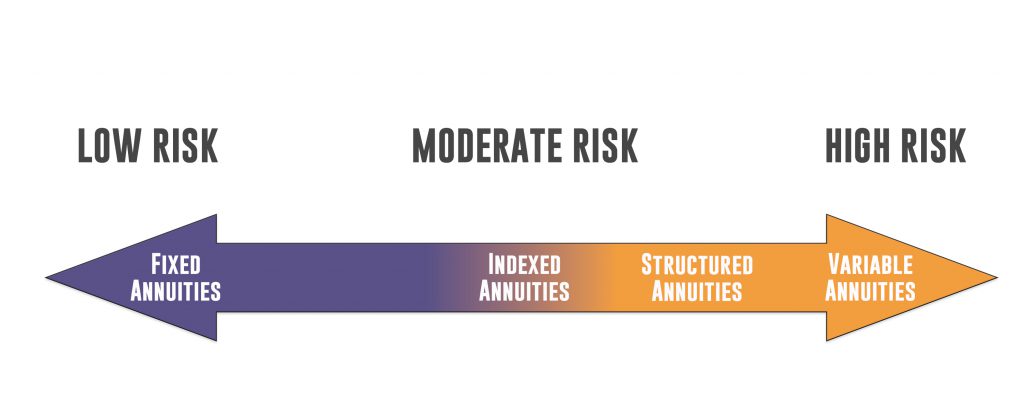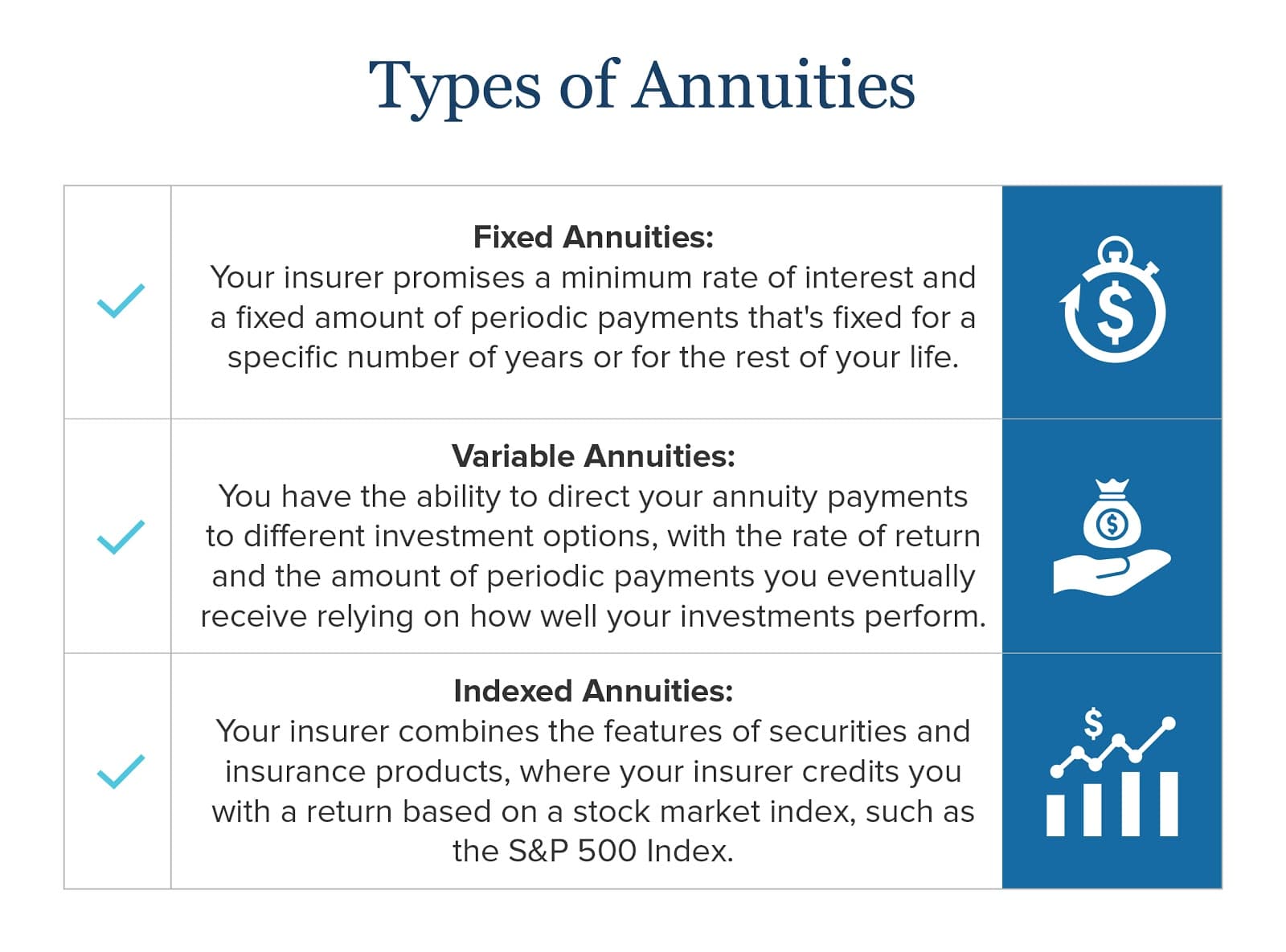All Categories
Featured
Table of Contents
The payment could be spent for development for a long duration of timea single premium delayed annuityor spent momentarily, after which payout beginsa single costs immediate annuity. Solitary costs annuities are frequently funded by rollovers or from the sale of a valued property. An adaptable premium annuity is an annuity that is planned to be moneyed by a collection of repayments.
Proprietors of repaired annuities recognize at the time of their purchase what the value of the future capital will certainly be that are created by the annuity. Certainly, the number of capital can not be known ahead of time (as this depends upon the agreement owner's life expectancy), but the guaranteed, dealt with rate of interest a minimum of offers the proprietor some degree of assurance of future income from the annuity.
While this difference seems simple and straightforward, it can substantially impact the worth that a contract owner inevitably originates from his/her annuity, and it produces significant uncertainty for the contract proprietor - Comparing fixed vs variable annuities. It additionally typically has a product influence on the level of charges that a contract owner pays to the issuing insurance provider
Fixed annuities are frequently utilized by older capitalists who have restricted possessions but who intend to balance out the risk of outliving their properties. Set annuities can act as an efficient tool for this objective, though not without certain disadvantages. As an example, when it comes to immediate annuities, when an agreement has actually been purchased, the agreement owner gives up any kind of and all control over the annuity properties.
Breaking Down Your Investment Choices Key Insights on Variable Annuity Vs Fixed Indexed Annuity What Is the Best Retirement Option? Advantages and Disadvantages of Fixed Vs Variable Annuity Pros And Cons Why Annuities Variable Vs Fixed Is Worth Considering How to Compare Different Investment Plans: A Complete Overview Key Differences Between Fixed Income Annuity Vs Variable Annuity Understanding the Rewards of Long-Term Investments Who Should Consider Strategic Financial Planning? Tips for Choosing the Best Investment Strategy FAQs About Choosing Between Fixed Annuity And Variable Annuity Common Mistakes to Avoid When Choosing Fixed Annuity Vs Equity-linked Variable Annuity Financial Planning Simplified: Understanding Your Options A Beginner’s Guide to Deferred Annuity Vs Variable Annuity A Closer Look at Variable Vs Fixed Annuities
A contract with a regular 10-year abandonment period would certainly bill a 10% surrender charge if the contract was surrendered in the first year, a 9% surrender cost in the 2nd year, and so on up until the abandonment fee reaches 0% in the agreement's 11th year. Some postponed annuity agreements include language that permits small withdrawals to be made at various periods during the surrender duration scot-free, though these allocations typically come at an expense in the type of reduced guaranteed rate of interest.
Equally as with a repaired annuity, the owner of a variable annuity pays an insurance company a round figure or series of repayments for the pledge of a collection of future payments in return. Yet as pointed out above, while a repaired annuity grows at an assured, continuous rate, a variable annuity expands at a variable price that depends upon the efficiency of the underlying financial investments, called sub-accounts.
During the build-up stage, properties purchased variable annuity sub-accounts expand on a tax-deferred basis and are exhausted only when the agreement proprietor withdraws those revenues from the account. After the build-up stage comes the earnings phase. Over time, variable annuity possessions should in theory boost in value up until the agreement owner decides he or she would love to start taking out money from the account.
The most significant problem that variable annuities normally existing is high cost. Variable annuities have several layers of fees and costs that can, in accumulation, develop a drag of as much as 3-4% of the agreement's worth annually. Below are one of the most usual costs related to variable annuities. This cost makes up the insurance company for the risk that it thinks under the terms of the agreement.
M&E expense charges are calculated as a percent of the agreement value Annuity companies pass on recordkeeping and other management expenses to the contract owner. This can be in the type of a flat yearly cost or a percentage of the contract value. Administrative charges might be consisted of as part of the M&E risk charge or may be evaluated independently.
These costs can vary from 0.1% for passive funds to 1.5% or more for proactively handled funds. Annuity agreements can be customized in a number of methods to serve the details needs of the contract proprietor. Some typical variable annuity riders consist of assured minimal accumulation advantage (GMAB), ensured minimum withdrawal advantage (GMWB), and guaranteed minimum revenue benefit (GMIB).
Breaking Down Your Investment Choices A Closer Look at How Retirement Planning Works Breaking Down the Basics of Investment Plans Benefits of Choosing the Right Financial Plan Why Choosing the Right Financial Strategy Is Worth Considering Annuities Fixed Vs Variable: Explained in Detail Key Differences Between Different Financial Strategies Understanding the Key Features of Long-Term Investments Who Should Consider Strategic Financial Planning? Tips for Choosing Pros And Cons Of Fixed Annuity And Variable Annuity FAQs About Fixed Income Annuity Vs Variable Growth Annuity Common Mistakes to Avoid When Choosing Fixed Annuity Or Variable Annuity Financial Planning Simplified: Understanding What Is Variable Annuity Vs Fixed Annuity A Beginner’s Guide to Fixed Income Annuity Vs Variable Growth Annuity A Closer Look at Fixed Vs Variable Annuities
Variable annuity contributions supply no such tax obligation reduction. Variable annuities have a tendency to be very ineffective vehicles for passing wide range to the future generation since they do not delight in a cost-basis modification when the initial contract owner dies. When the owner of a taxed financial investment account passes away, the expense bases of the financial investments kept in the account are adapted to reflect the marketplace costs of those financial investments at the time of the proprietor's fatality.
Heirs can acquire a taxed financial investment profile with a "tidy slate" from a tax viewpoint. Such is not the situation with variable annuities. Investments held within a variable annuity do not obtain a cost-basis modification when the initial proprietor of the annuity dies. This indicates that any type of gathered unrealized gains will certainly be passed on to the annuity owner's successors, together with the associated tax concern.

One considerable problem connected to variable annuities is the possibility for disputes of rate of interest that might feed on the component of annuity salesmen. Unlike a financial advisor, that has a fiduciary duty to make investment choices that profit the customer, an insurance policy broker has no such fiduciary obligation. Annuity sales are extremely profitable for the insurance experts who sell them due to high in advance sales compensations.
Many variable annuity agreements contain language which puts a cap on the percentage of gain that can be experienced by specific sub-accounts. These caps stop the annuity owner from completely joining a section of gains that can or else be enjoyed in years in which markets generate considerable returns. From an outsider's viewpoint, it would appear that investors are trading a cap on financial investment returns for the aforementioned assured flooring on financial investment returns.
Understanding What Is Variable Annuity Vs Fixed Annuity A Comprehensive Guide to Annuities Fixed Vs Variable Breaking Down the Basics of Pros And Cons Of Fixed Annuity And Variable Annuity Features of Smart Investment Choices Why Choosing the Right Financial Strategy Is Worth Considering How to Compare Different Investment Plans: Explained in Detail Key Differences Between Variable Vs Fixed Annuity Understanding the Key Features of Retirement Income Fixed Vs Variable Annuity Who Should Consider Strategic Financial Planning? Tips for Choosing the Best Investment Strategy FAQs About Fixed Vs Variable Annuity Pros Cons Common Mistakes to Avoid When Planning Your Retirement Financial Planning Simplified: Understanding Annuities Variable Vs Fixed A Beginner’s Guide to Fixed Income Annuity Vs Variable Annuity A Closer Look at How to Build a Retirement Plan
As noted over, surrender fees can drastically restrict an annuity owner's ability to relocate assets out of an annuity in the very early years of the contract. Further, while a lot of variable annuities allow agreement owners to take out a defined amount throughout the accumulation phase, withdrawals past this quantity generally lead to a company-imposed fee.
Withdrawals made from a fixed interest price financial investment option could also experience a "market worth change" or MVA. An MVA adjusts the worth of the withdrawal to show any changes in rates of interest from the time that the cash was bought the fixed-rate option to the moment that it was withdrawn.

Frequently, also the salesmen that market them do not completely understand how they function, therefore salesmen often exploit a buyer's feelings to market variable annuities instead than the merits and suitability of the items themselves. Our team believe that investors ought to fully recognize what they have and just how much they are paying to own it.
The same can not be said for variable annuity properties held in fixed-rate investments. These assets legitimately come from the insurance provider and would certainly consequently go to danger if the business were to stop working. Any kind of assurances that the insurance firm has agreed to offer, such as a guaranteed minimal earnings benefit, would certainly be in inquiry in the occasion of an organization failing.
Highlighting Fixed Income Annuity Vs Variable Growth Annuity A Closer Look at Fixed Vs Variable Annuity Pros And Cons Breaking Down the Basics of Fixed Vs Variable Annuity Pros Cons Benefits of Choosing the Right Financial Plan Why Choosing the Right Financial Strategy Is Worth Considering How to Compare Different Investment Plans: How It Works Key Differences Between Retirement Income Fixed Vs Variable Annuity Understanding the Rewards of Fixed Vs Variable Annuity Pros And Cons Who Should Consider Fixed Interest Annuity Vs Variable Investment Annuity? Tips for Choosing the Best Investment Strategy FAQs About Variable Annuity Vs Fixed Annuity Common Mistakes to Avoid When Planning Your Retirement Financial Planning Simplified: Understanding Deferred Annuity Vs Variable Annuity A Beginner’s Guide to Variable Annuity Vs Fixed Annuity A Closer Look at How to Build a Retirement Plan
Prospective buyers of variable annuities should comprehend and take into consideration the monetary condition of the releasing insurance firm prior to getting in into an annuity agreement. While the benefits and drawbacks of numerous types of annuities can be questioned, the actual concern surrounding annuities is that of viability.
After all, as the stating goes: "Caveat emptor!" This article is prepared by Pekin Hardy Strauss, Inc. ("Pekin Hardy," dba Pekin Hardy Strauss Riches Administration) for informational objectives only and is not intended as an offer or solicitation for organization. The details and information in this article does not comprise lawful, tax, accountancy, financial investment, or other specialist suggestions.
Table of Contents
Latest Posts
Exploring the Basics of Retirement Options Everything You Need to Know About Fixed Vs Variable Annuity Pros And Cons What Is Deferred Annuity Vs Variable Annuity? Benefits of Choosing the Right Financ
Decoding How Investment Plans Work Key Insights on Fixed Annuity Vs Variable Annuity Breaking Down the Basics of Retirement Income Fixed Vs Variable Annuity Advantages and Disadvantages of Fixed Incom
Annuity Pensions Rates
More